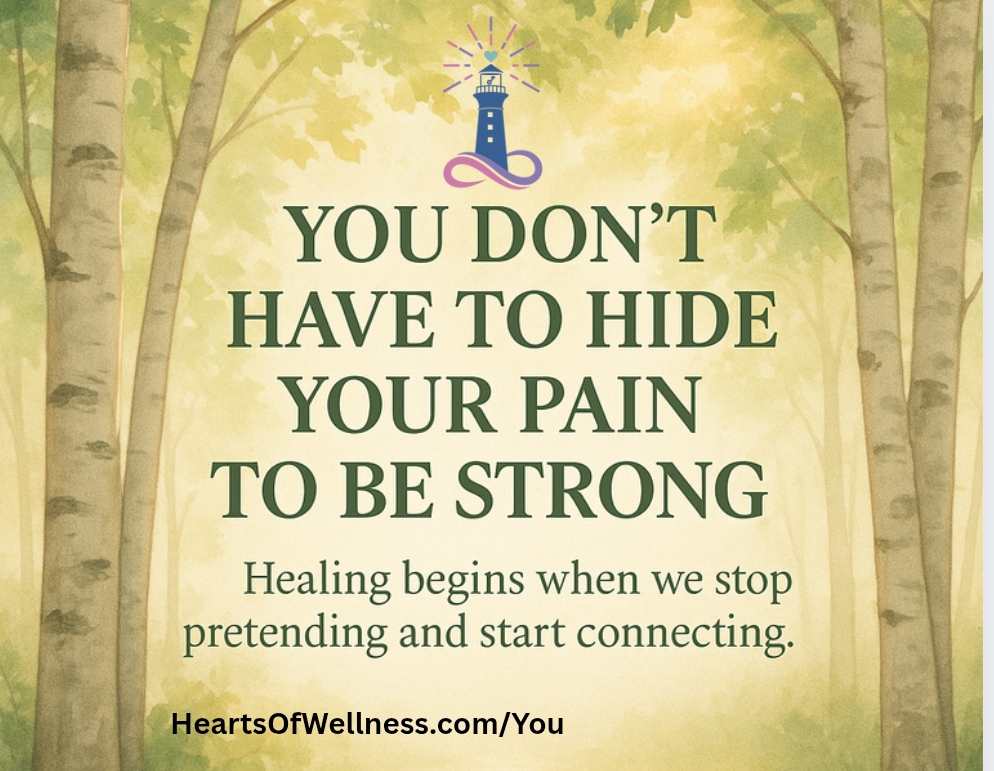By Wendy Bjork, MS Mentor and Founder of HeartsOf Wellness.com
You’re not just dealing with a chronic illness—you’re often navigating it alone, hidden behind a smile, carefully shielding your world from constant fatigue, pain, and unpredictability.
Why We Conceal Chronic Conditions
1. Stigma & Judgment
Invisible symptoms may lead others to question your credibility—”You’re too young to be that sick.” Disclosure might prompt suspicion or pity, so many choose to stay silent.
2. Fear of Professional Fallout
Concerns about being perceived as less capable can push people to hide their symptoms at work or school, foregoing necessary accommodations out of anxiety about career setbacks.
3. Protecting Loved Ones
Carrying the weight of worry for family or friends often means shouldering pain in private—minimizing symptoms to avoid burdening those we care about.
What Secrecy Can Cost
Delayed Diagnosis or Treatment
Withholding symptoms delays medical attention. The CDC notes chronic conditions can last over a year and need ongoing care or disrupt daily life .
Mental and Emotional Toll
Constantly masking your reality breeds stress, isolation, and even depression. Covering pain is exhausting, adding psychological strain on top of physical suffering.
Difficulty in Daily Planning
When flare-ups are hidden, expectations at home or work go unchecked. That unpredictability chips away at relationships and your self-worth.
Taking Control: Strategies to Cope
1. Confide Selectively
Identify trusted people and share what you feel they need to know, on your terms. Trust small steps in revealing your reality.
2. Keep a Symptom Log
Documenting flares, fatigue, or pain empowers you with proof—important for both healthcare and self-validation.
3. Use Practical Language
Describe symptoms in concrete terms: “I’m really wiped out today,” “This flare will slow me down.” Aim for understanding, not justification.
4. Request Proper Accommodations
Know your rights—ask for modifications like flexible schedules or rest breaks. It’s legitimate and essential.
5. Join Your Community
Support groups connect you with people who get it. Seeing others share similar struggles is validating and reduces shame.
Expert Voices
The CDC highlights that chronic diseases are the top cause of disability and death in the U.S., and they impact 6 in 10 Americans, with 4 in 10 managing more than one .
Mental health experts emphasize that hiding illness amplifies anxiety and depression. Embracing self-compassion and pacing oneself are essential first steps toward wellbeing.
Keeping your condition a secret may feel safe—but it can also be isolating and harmful. Gradually sharing your truth with trusted people, using tools like symptom trackers, and connecting with others facing similar challenges can help reclaim your sense of control and belonging.
You’re not defined by your illness—and you don’t have to face it alone.
Additional Resources
Download your 30 Days to Take Charge of Your MS Symptoms workbook at HeartsOfWellness.com/you. This guided resource supports you with simple, daily steps to help you reconnect with your body, calm your mind, and create clarity on your healing path.
Wendy Bjork is an international bestselling author, nationally syndicated columnist, inspirational speaker, and founder of HeartsOfWellness.com. Known as The MS Mentor, Wendy empowers women living with Multiple Sclerosis to build a strong Foundation of Wellbeing—One Whole-istic™ Step at a Time.
Diagnosed with MS at just 15, she has navigated over three decades of challenges and triumphs. Her lived experience revealed the gaps in care, connection, and clarity that many women with chronic conditions face. Today, Wendy is dedicated to bridging those gaps, offering guidance, community, and tools to help others reclaim their power and live with purpose.






